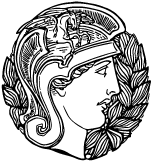A selection of sculpture in the collection includes the following busts of Athenæum members and objects of historical interest such as the replica of columns from the Roman Forum. Sculptures can be seen atop the alcoves around the main hall of the library, perched above bookcases in the Art Room, and displayed on pedestals in the Philbrick Rare Book Room.
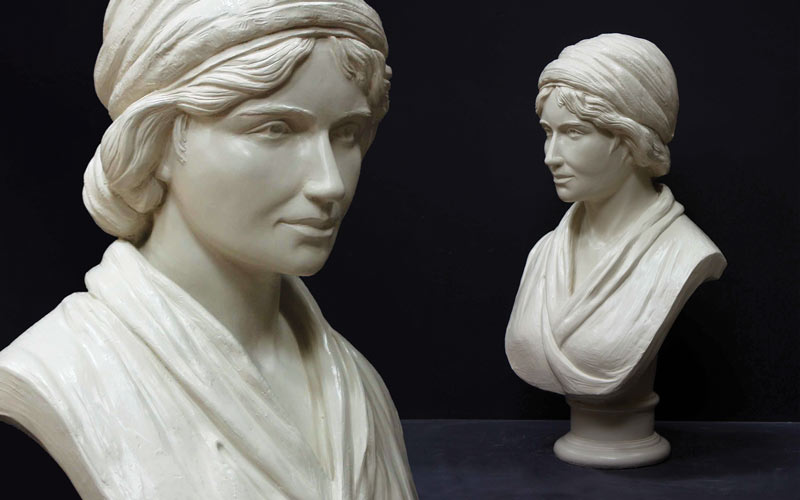
Mary Wollstonecraft, 2020. Robert Shure [Skylight Studios]. Funded by the Hayden Special Collections Development Fund.
In 2019, the Athenæum commissioned an original bust of Mary Wollstonecraft [1759-1797], English writer, philosopher, and pioneer of women’s rights, by artist Robert Shure of Skylight Studios, Woburn, MA. The bust was modeled after the painting of Wollstonecraft completed in 1797 by John Opie [1761-1807], for which she sat while pregnant with her daughter Mary Wollstonecraft Shelly (née Godwin) [1797-1851]. This is the first known sculpture of Wollstonecraft in North America. Learn more about the Bust Project here.
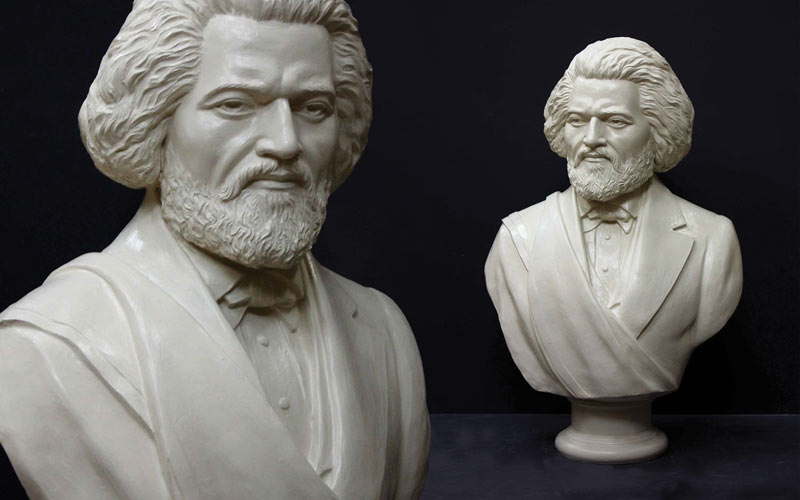
Frederick Douglass (after Johnson Mundy)>, 2020. Skylight Studios. Funded by the Hayden Special Collections Development Fund.
The Athenæum’s bust of American abolitionist Frederick Douglass [1818-1895] is after the 1879 work by sculptor Johnson Mundy [1832-1897], which is part of the collection of the University of Rochester, NY. Commissioned by members of the Rochester community, Mundy modeled the marble bust from life. The sculpture portrays Douglass in contemporary shirt, jacket, and tie. A toga-like cloth is draped over his right shoulder, representing his democratic ideals and underscoring his stature as a national figure. Douglass spoke of Mundy’s bust, “The more I look at the bust, the better I like it. There is a fullness and a completeness about it which I have not often found in that class of work,” and went on to remark, “I am content to be made known through this specimen of your art to all who may come after me, and who may wish to know how I looked in the world.” Learn more about the Bust Project here.

Louisa May Alcott (after Walton Ricketson), 2020. Skylight Studios. Funded by the Hayden Special Collections Development Fund.
The Athenæum’s bust of the American author Lousia May Alcott [1832-1888] is after the 1892 work completed by the sculptor Walton Ricketson [1839-1923], now part of the collection of the Concord Free Public Library Corporation in Concord, MA. Ricketson completed two artistic renditions of Alcott, including a bas-relief medallion done from life a few years earlier. The bust was produced posthumously and initially owned by Alcott’s sister, Anna Alcott Pratt. Learn more about the Bust Project here.
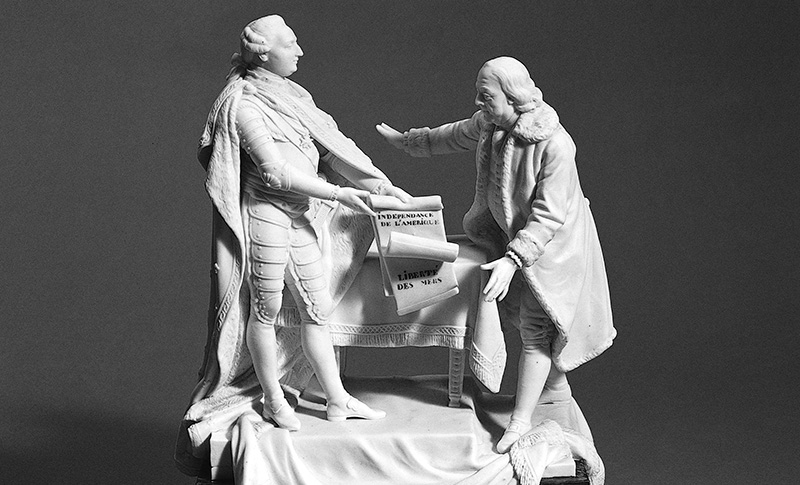
Figure group of Benjamin Franklin and Louis XVI signing the Treaty of Alliance in 1778. c. 1780-85. Attributed to Charles Gabriel Sauvage, known as Lemire (French, 1741–1827). Unglazed white porcelain. Gift of William Anthony Hoppin, 1915.
Lemire was a studio director of the Niderviller ceramics factory in Lorraine—an important center of French faience and porcelain production—but he was also an accomplished sculptor who exhibited regularly at the Paris Salon. His work ranged from the allegorical to the political, and includes this portrayal of the 1778 signing of the Treaty of Amity and Commerce between the United States and France. It depicts Benjamin Franklin, the new country’s Minister Plenipotentiary, conveying gratitude to Louis XVI, who presents the treaty. The document allowed for the mutual protection of commercial and military vessels in French and American waters and, more importantly, marked an important alliance during the American Revolutionary War. The figural group was originally owned by William Jones Hoppin, a lawyer, diplomat, and writer, and it descended to his nephew, William Anthony Hoppin, who bequeathed it to the Providence Athenæum on his death in 1915. This porcelain sculpture is one of only six known copies Lemire produced. It was viewed by over 300,000 people when it was lent by the Athenæum to an exhibition entitled “The European Vision of America” that was held in Cleveland, Ohio, Washington, D.C., and Paris in 1976 as part of the Bicentennial celebrations.
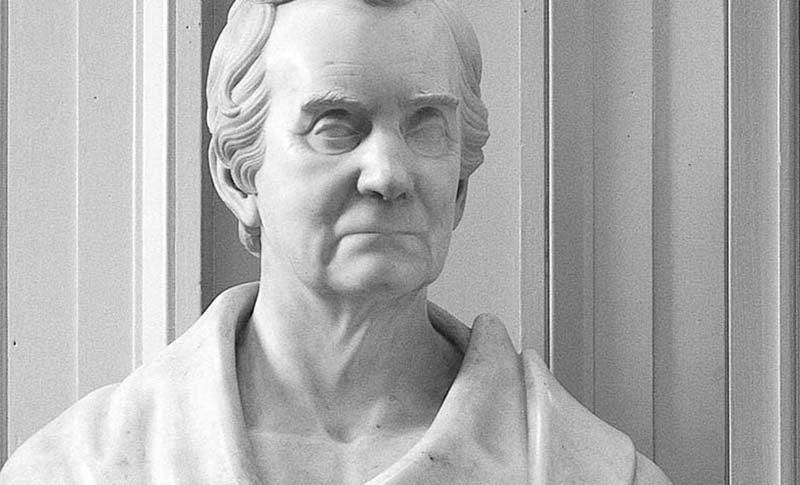
The Honorable John Pitman, ca. 1853. George O. Annable (American, 1829–1887). Marble. Gift of the Friends of the Athenæum, 1853.
John Pitman served as a U.S. District Court judge in Providence for nearly forty years, beginning in 1824, and also served as the first President of the Providence Athenæum. This portrait bust was commissioned by friends of the Athenæum from the local artist, George O. Annable. Annable had studied drawing under miniaturist Jane Catherine Chapin but later turned to sculpture, working mainly in cameo cutting. For his portrait cameos, he received the top prize at the 1851 exhibition of the Rhode Island Society for the Encouragement of Domestic Industry. Though he typically worked in small scale, he completed at least two portrait busts of local community leaders before leaving Providence for Brooklyn, New York. This marble sculpture recognized Pitman’s efforts on behalf of the Athenæum and joined the institution’s collection of plaster busts representing important scholars and statesmen.

Albert J. Jones, circa 1880s. Anonymous. Donated by Mr. Jones’s sister, Mrs. Emily A. Hall.
Albert Jones was secretary of the Athenaeum in the 1840s before moving to Rome. The panoramic photograph of the Coliseum was a gift of Jones to the Athenæum in 1860. Upon his death in 1890, his estate provided a book fund to purchase books “illustrating the art of design as applied to Decoration or Industrial Art.” The bust was said to be “a striking likeness.”
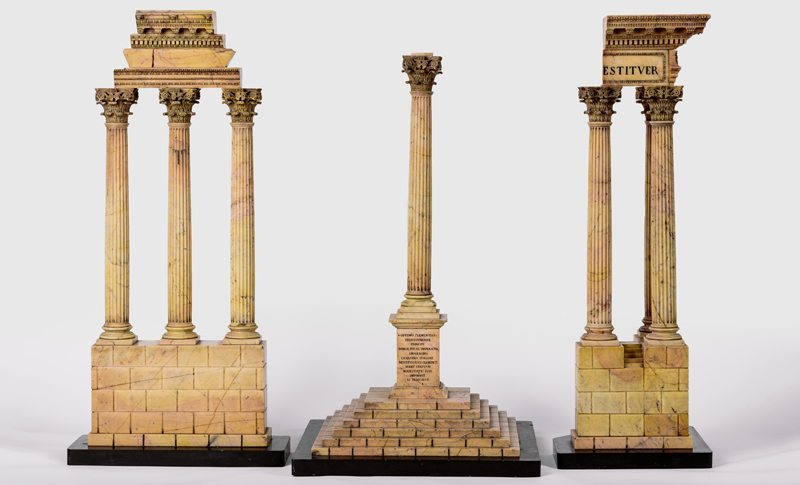
Column of Phocas, Temple of Vespasian, Temple of Castor & Pollux, Roman Forum, 1861. Anonymous. Antique marble. Presented by Rev. Dr. Alexis Caswell, 1861. Athenæum Member 1836-1877 & President of Brown University, 1868-72.
“Every visitor in Rome makes it almost his first business to hasten to the Forum, to see them in their grandeur and their desolation. When I was here during the last winter, as I gazed again and again upon them, it occurred to me that I could not render a better service to the Providence Athenæum, than by placing accurate copies of these much admired remains of ancient art in its halls. I hoped, also, that they would interest and gratify the public, and would be especially welcomed by the lovers of art; and minister, in some degree, to the growth of a correct architectural taste among us.” – Rev. Dr. Alexis Caswell (1799-1877)



